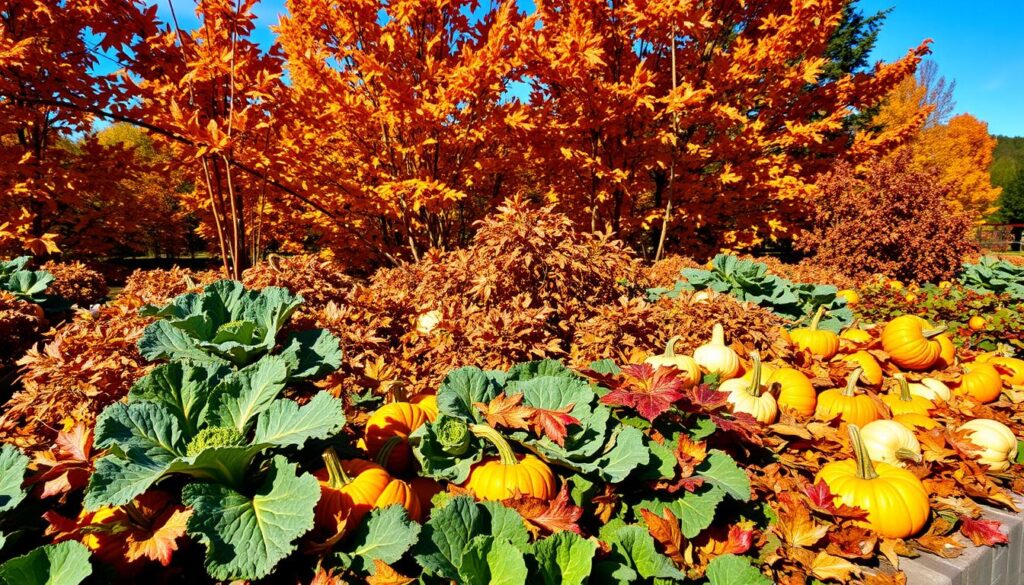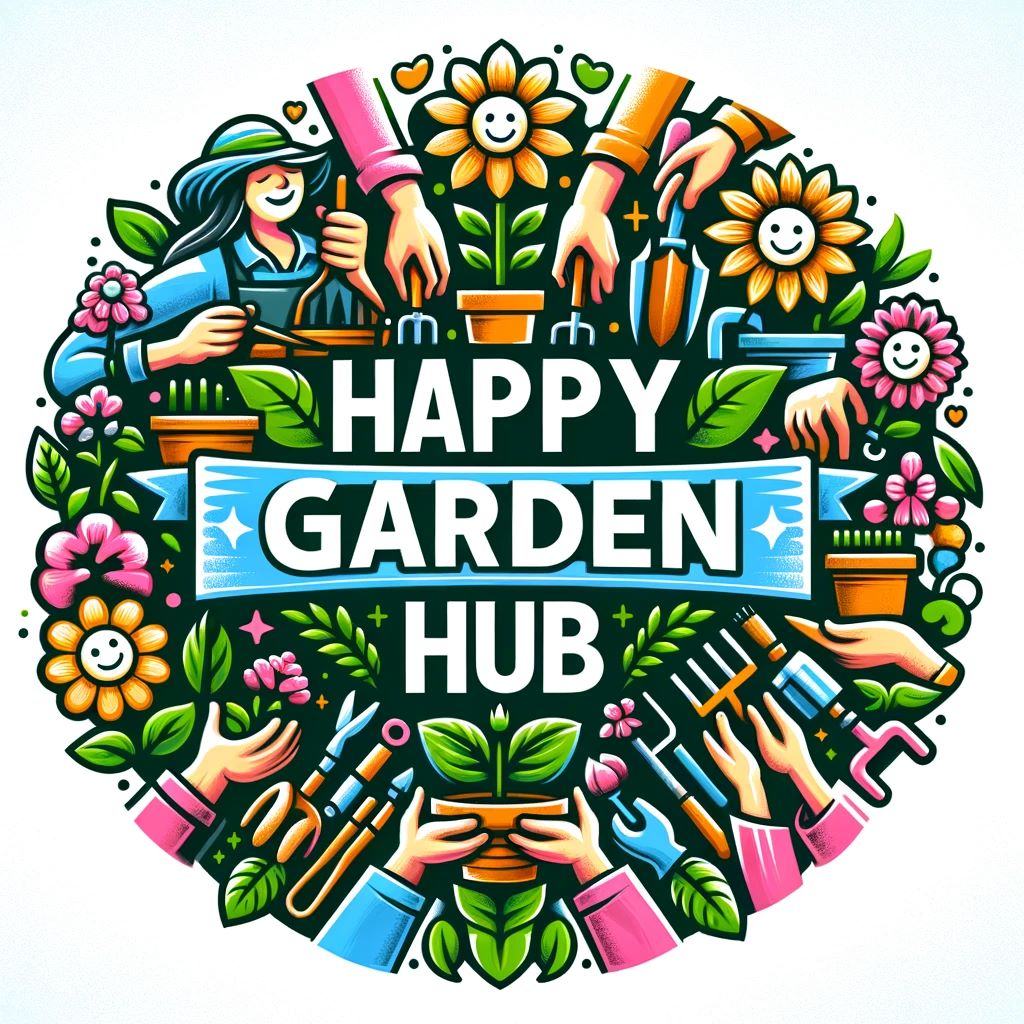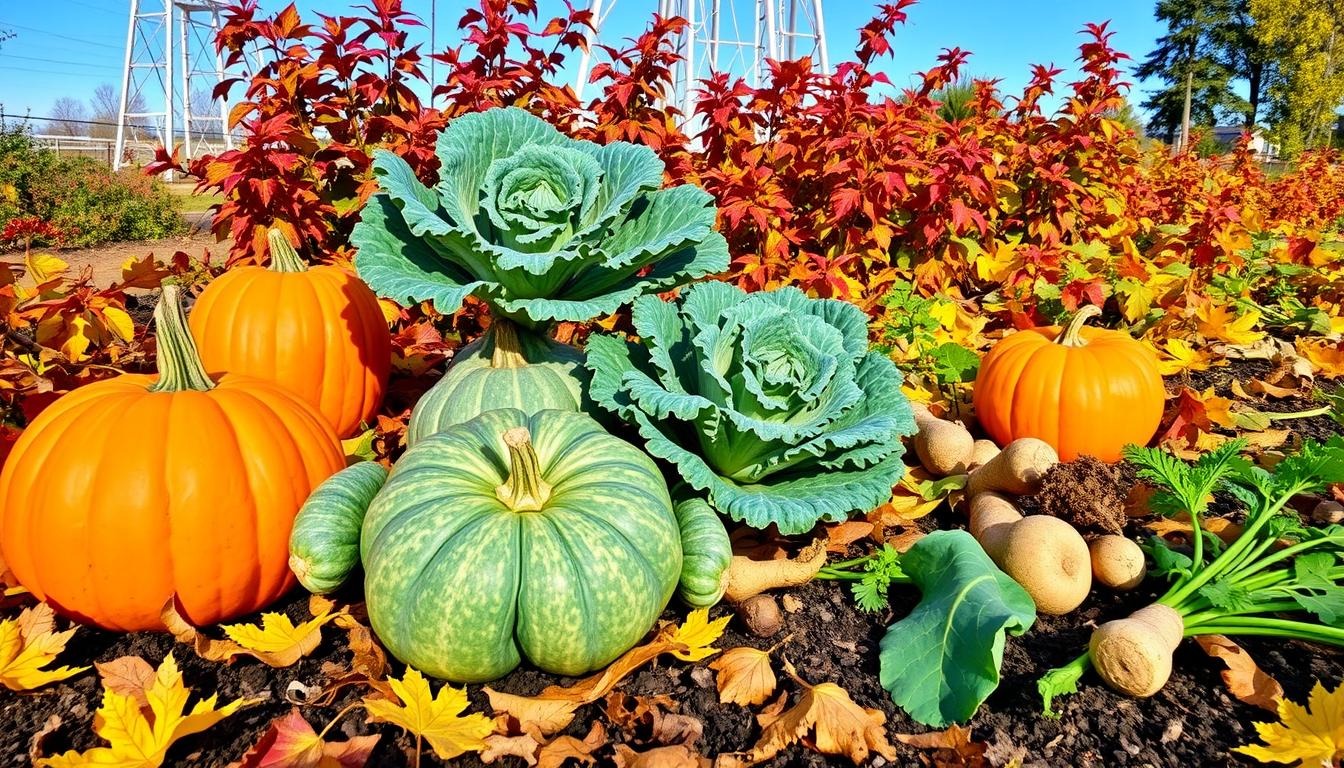This post contains affiliate links.
As summer fades, a new chance blooms in your garden. Remember the joy of picking that first ripe tomato? Now, imagine enjoying crisp, sweet carrots on a cool fall evening. Fall gardening is more than just extending your harvest. It opens a door to new flavors and experiences.
Picture yourself with a warm mug of tea, surrounded by vibrant greens and plump vegetables. The air is crisp, filled with the earthy smell of fresh soil. This is more than gardening; it’s connecting with nature, celebrating its rhythms, and promising a rich harvest.
When you plan your fall garden, you’re planting hope for the future. Each plant you put in the ground means fresh, healthy food on your table after summer ends. It’s a way to grow life as winter approaches, a bold act of defiance against the seasons.
Key Takeaways
- Fall vegetable gardening extends your harvest season
- Cool-weather crops thrive in autumn conditions
- Planting in fall can lead to better plant production
- Fall gardens require less watering due to cooler temperatures
- Planning your fall garden starts in mid-to-late summer
- Many spring vegetables can be replanted for fall harvest
Did you know beets and green onions can survive in the high 20s? Kale and cabbage can even handle temperatures down to 20°F. This resilience makes fall gardening rewarding. You’re not just growing food; you’re working with nature to produce crops that are sweeter and more flavorful than in summer.
Timing is crucial in fall gardening. Bush snap beans take 45 to 65 days to mature but can’t handle frost. Spinach, however, can survive light frost and might even last through winter. Knowing these details helps you create a garden that feeds you and nourishes your soul.
Understanding Fall Vegetable Gardening
Fall vegetable gardening lets you enjoy fresh produce even in the cold months. By planting cool season crops, you can have a harvest that lasts. Let’s explore the benefits and best conditions for growing frost hardy vegetables.
Benefits of Growing Fall Vegetables
Autumn gardening has many perks. You’ll deal with fewer pests and weeds, making it easier to keep your garden tidy. Cool season crops like spinach and kale get better in taste after being exposed to cold.
- Extended harvest season
- Improved flavor of certain vegetables
- Reduced pest problems
- Less watering required
Ideal Conditions for Autumn Gardening
Fall gardening does well in warm soil and cool air. This mix helps seeds grow fast and plants get strong. Most fall veggies need about an inch of water each week. Frost hardy veggies like cabbage, broccoli, and Brussels sprouts can handle temperatures down to 20°F.
Extending the Growing Season
With good planning, you can keep harvesting into fall and winter. Plant quick-growing veggies like radishes and spinach in September for a quick harvest. For veggies that stay in the ground over winter, mulch them before the ground freezes to keep them alive.
| Vegetable | Days to Maturity | Frost Tolerance |
|---|---|---|
| French Breakfast Radishes | 25 days | Light frost (30-32°F) |
| Spinach | 40 days | Hard frost (below 28°F) |
| Broccoli | 50-60 days | Hard frost (20°F) |
By knowing these tips, you can make a fall garden full of tasty, frost hardy veggies. These will keep your table fresh long after summer ends.
Plant Fall Vegetables: Essential Crops for Your Garden
Fall vegetable gardening lets you grow food into autumn. As summer ends, cool season crops do well. They give you lots of food in the fall. Let’s look at some key vegetables for your fall garden.

Leafy greens like spinach, kale, and lettuce love the cool. They grow fast and are full of nutrients. You can pick them in about 30 days after planting. Plant them every two weeks for a steady supply.
Root veggies such as carrots, beets, and radishes are great for fall. They get sweeter as it gets colder. Radishes grow super fast, ready in 4-6 weeks.
Brassicas like broccoli, cauliflower, and Brussels sprouts do well in the fall. They’re full of vitamins and can last through mild winters. They add healthy food to your meals.
Don’t overlook alliums. Garlic and onions planted in the fall will be ready for summer. These plants can handle temperatures down to 20°F.
| Vegetable | Planting Time | Days to Harvest |
|---|---|---|
| Spinach | 6-8 weeks before frost | 30-45 days |
| Radishes | 4-6 weeks before frost | 20-30 days |
| Carrots | 10-12 weeks before frost | 60-80 days |
| Garlic | 4-6 weeks before frost | Next summer |
Timing is key in fall gardening. Start about six weeks before the ground freezes. With good planning and care, you’ll have a variety of tasty food in the fall.
Preparing Your Garden for Fall Planting
Fall gardening gives you another chance to grow tasty vegetables. To succeed, you need to prepare your soil well for fall planting. Let’s look at how to get your garden ready for autumn crops.
Soil Preparation and Amendment
First, test your soil’s pH level. For fall veggies, aim for a pH between 6.2 and 6.8. Add compost or well-rotted manure to boost nutrients. This is very important, especially if summer crops took a lot out of the soil.
Clearing Summer Crops
Take out the summer plants to make space for fall ones. Mix in the residues from summer plants to add organic matter. If you’re concerned about diseases, remove the debris to compost it separately. This stops diseases from surviving the winter in your garden.
Planning Your Fall Garden Layout
Make a plan for your vegetable garden that includes crop rotation and companion planting. Put bigger plants like broccoli and cabbage 1 to 2 feet apart, with 3 feet between rows. For smaller plants, space them out less.
| Crop | Days to Harvest | Frost Tolerance |
|---|---|---|
| Lettuce | 45-50 days | Moderate |
| Radishes | 25 days | High |
| Spinach | 40-50 days | High |
| Bush Beans | 42-56 days | Low |
Water your new seeds and plants every day for the first week. Use organic mulch to keep the soil moist and stop weeds. With these steps, your garden will be ready for a great fall harvest.
Cool-Season Crops: Leafy Greens and Brassicas

Fall is perfect for growing cool season crops. Leafy greens and brassicas love the cool air, letting gardeners harvest into the cooler months. These frost hardy vegetables are great for your autumn garden.
Leafy greens like lettuce, spinach, and arugula do well in fall’s mild weather. They grow fast, so you can harvest them many times. Brassicas, including broccoli, cabbage, and kale, are also great for cool seasons. They can handle light frosts and taste sweeter after being cold.
“Cool-season crops do best in average temperatures ranging from 55°F to 75°F.”
To get the most from your autumn harvest, try succession planting. This means planting seeds every few weeks for a steady supply of greens. Keep young plants safe from pests like slugs and cabbage worms to keep your crops healthy.
| Vegetable Type | Examples | Planting Time |
|---|---|---|
| Leafy Greens | Lettuce, Spinach, Arugula | Mid-August to September |
| Brassicas | Broccoli, Cabbage, Kale | Late July to Early August |
| Root Vegetables | Carrots, Beets, Turnips | Late July to End of July |
Adding cool season crops to your garden means more autumn harvests and using your space all year. Make sure to prepare your soil, plan when to plant, and protect your crops from early frosts for a successful fall garden.
Root Vegetables for Fall Planting
Fall is a great time to grow delicious root vegetables. These underground crops love the cooler weather and get sweeter as the soil cools down. Let’s look at some popular root vegetables and how to add them to your garden.
Carrots and Beets
Carrots and beets are top choices for fall gardens. Plant carrots in late summer for quick germination. The cool autumn soil makes them taste sweeter and have fewer imperfections.
For beets, sow seeds 8 to 12 weeks before the first frost. Soaking beet seeds in water for 4 hours helps with germination. Adding 1 tablespoon of borax to a gallon of water and spraying it on your beet rows can help them grow bigger.
Radishes and Turnips
Radishes and turnips are great for extending your garden’s season. Radishes do best in soil that’s 60 to 80°F. They grow fast and taste better as the weather cools.
Turnips take about 60 days to mature and prefer temperatures around 60°F. They grow quickly, so you can plant them later than other fall root vegetables.
Harvesting and Storage Tips
Harvesting root vegetables at the right time is key. Try to pick them before the ground freezes. For long storage, keep them in a cool, dark place like a fridge or root cellar.
This way, you can enjoy your homegrown produce all winter. It makes your fall gardening efforts truly rewarding.
| Root Vegetable | Days to Maturity | Optimal Growing Temperature | Storage Method |
|---|---|---|---|
| Carrots | 70-80 days | 60-70°F | Root cellar or refrigerator |
| Beets | 55-70 days | 50-65°F | Root cellar or refrigerator |
| Radishes | 20-30 days | 60-65°F | Refrigerator |
| Turnips | 40-60 days | 60-65°F | Root cellar or refrigerator |
Alliums: Onions, Garlic, and Shallots
Fall is a great time to grow alliums. This group includes onions, garlic, shallots, leeks, and chives. These plants are perfect for making your garden last longer and even surviving the winter in some cases.
Planting alliums in the fall lets them build strong roots over winter. They’ll be ready to eat in late spring or early summer. This makes them great for gardeners who want to keep their garden busy all year.
- Plant garlic cloves and onion sets in well-drained soil before the ground freezes
- Mulch allium beds to protect from extreme temperature fluctuations
- Start shallots for earlier harvests than onions
Here’s a comparison of popular allium varieties for fall planting:
| Allium | Planting Time | Harvest Time | Special Notes |
|---|---|---|---|
| Garlic | 6 weeks before ground freeze | Late spring/early summer | Plant individual cloves |
| Onions | 10 weeks before transplanting | Late spring/early summer | Start from seeds or sets |
| Shallots | Fall (Halloween to Thanksgiving) | Earlier than onions | Can overwinter if left unharvested |
Adding alliums to your fall garden does more than just add flavor to your dishes. It also uses your garden space well and keeps your garden going into the cooler months.
Timing Your Fall Planting Schedule
Creating a successful vegetable planting schedule for fall takes careful planning. It’s all about knowing the right frost dates and how hardy your plants are. Let’s explore the key steps to timing your fall plantings.
Calculating Planting Dates
First, find out when the first fall frost hits your area. For instance, in Goldsboro, this usually happens on October 30. Then, count back from that date for each vegetable’s growth time. Don’t forget to add more days for slower growth in the cooler weather.
Succession Planting Strategies
Succession planting keeps your garden full of produce all season. Plant quick-growing crops like lettuce every two weeks for a steady harvest. This method is great for leafy greens and root vegetables too.
Frost Dates and Plant Hardiness
Knowing how hardy your plants are is crucial for a longer growing season. Many frost-resistant vegetables taste better after a light frost. For example, peas and cauliflower can handle temperatures as low as 28°F. Broccoli, kale, and spinach can even survive hard freezes down to 25°F.
| Vegetable | Planting Date | Frost Tolerance |
|---|---|---|
| Beets | August 1-15 | Moderate |
| Broccoli | August 15-September 15 | High |
| Carrots | August 1-15 | High |
| Kale | August 15-September 15 | Very High |
| Spinach | August 25-September 15 | Very High |
By using this planting schedule and picking frost-hardy vegetables, you’ll set yourself up for a great fall harvest. Happy gardening!
Protecting Your Fall Garden from Frost
When you start fall vegetable gardening, protecting your crops from cold nights is key. Frost hardy vegetables are great for extending the growing season. Plants like peas, radishes, and kale can handle light frosts, even when it gets as cold as 25°F (-3°C).
For plants that are more delicate, like tomatoes and peppers, you’ll need to act fast. Use big plastic pots, blankets, or move potted plants inside to keep them safe from frost. A garden that’s watered in the late afternoon is also less likely to freeze, helping your fall garden do well.
Watch the weather closely. A Frost Advisory means temperatures will be between 36°F and 32°F. A Freeze Warning warns of a high chance of temperatures below 32°F. In places like Missoula, where the first frost usually happens on September 22nd, being prepared is crucial. With the right protection, your fall garden can flourish into the cooler months, giving you a great harvest.
FAQ
What are the benefits of growing fall vegetables?
What are the ideal conditions for fall vegetable gardening?
What are some essential crops for fall vegetable gardens?
How do you prepare your garden for fall planting?
What are some popular leafy greens and brassicas for fall gardens?
How do you grow and harvest root vegetables in the fall?
Can you plant alliums like onions and garlic in the fall?
How do you time your fall planting schedule?
How do you protect your fall garden from frost?
This post contains affiliate links.

